Download Printable Watermelon Growing Guide »
Almost everything homegrown in the garden tastes better than its grocery store counterpart, but watermelon might take the cake as the most improved. It’s packed full of so much more juicy, layered flavor than anything you can grab at a supermarket—you don’t know watermelon until you bite into your own homegrown melon that’s still warm from the sun!
The great news: watermelon is relatively easy to grow! It takes a long season and thrives in hot weather, but give it some space to sprawl, and it’s mostly maintenance-free! Let’s get you growing some melons.
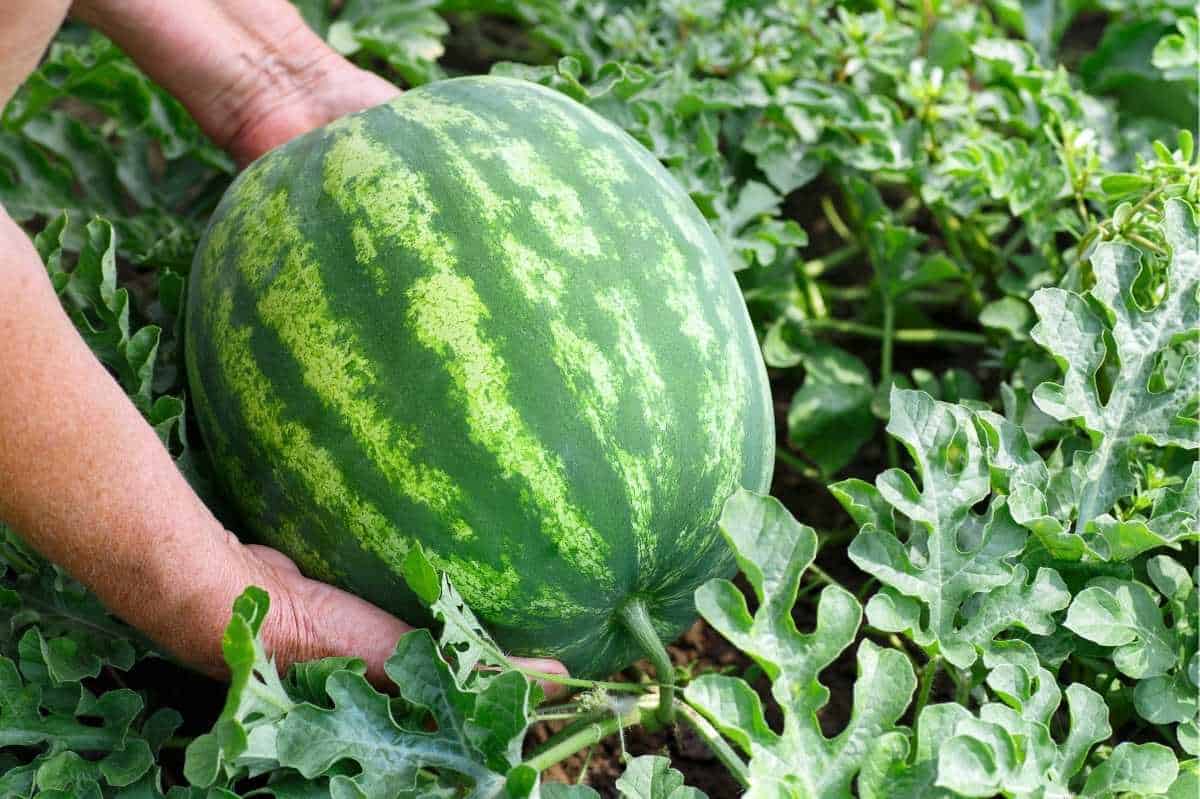
Table of Contents
Are watermelon easy to grow?
If you can grow a cucumber or a zucchini, you can grow a watermelon! Watermelon plants are remarkably prolific, and as long as your climate is hot enough (or you can fake it with poly tunnels or cold frames), watermelons are a breeze to get going.
When should I plant watermelon?
Watermelon requires a relatively long growing season (about 80-90 days from sowing the seeds), and it wants absolutely nothing to do with cool weather. Plant your watermelon when the soil has warmed to around 70ºF and there are no longer any cool nights in the forecast. For many people, this is actually two to three weeks after their last frost date in the spring.
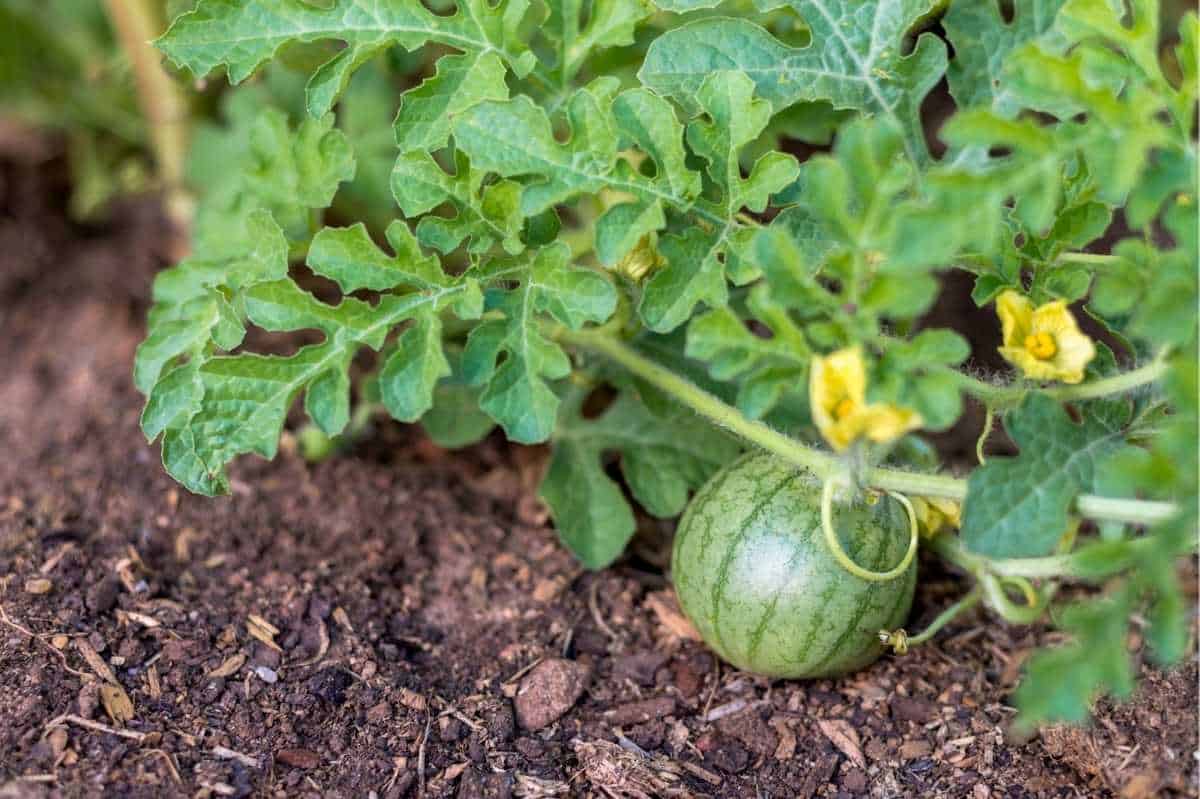
How long does it take for a watermelon to grow to full size?
Watermelons require 80-90 days from seed sowing to grow a full-size watermelon. Some smaller-sized watermelons (like Sugar Baby) can reach maturity in closer to 70 days.
What watermelon varieties should I grow?
The fun thing about growing watermelon is that there are so many options beyond the standard red watermelon you see at your grocery store—you can grow yellow, orange, and even white-flesh watermelon! These are some of our favorite varieties:
- Moon and Stars—This legendary heirloom watermelon is named for the interesting markings on its rind. Melons can grow up to 40 pounds each!
- Sugar Baby—This small-sized seeded watermelon lives up to its name. It is so sweet, you’ll swear someone sprinkled sugar on it! The melons are about 10″ across, and you can get as many as 4-6 per watermelon vine. There is also Sugar Baby Bush, which is the same watermelon but grown on a patio-friendly plant with a bush habitat.
- Orangeglo Watermelon—Many orange and yellow watermelon varieties are fun to look at, but don’t offer much in the way of flavor, but not Orangeglo!
- Blacktail Mountain—For those of you with shorter, cooler summers, Blacktail Mountain might be a good option for you. It’s an early ripener (taking only about 70 days for a full size watermelon) with great flavor.
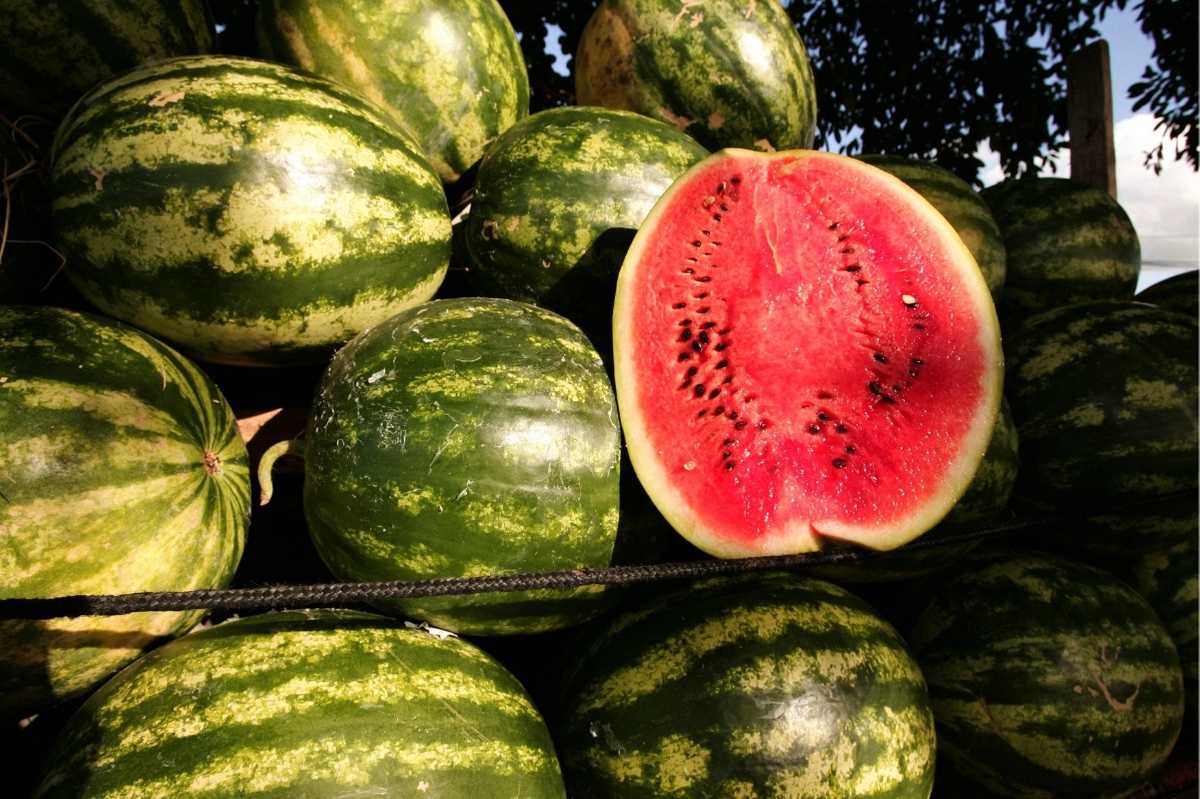
Should I grow watermelon from seeds or plants?
Like all cucurbits, watermelon prefers to stay put and not be transplanted. In most climates, you’ll do best to directly sow watermelon seeds in warm soil in the bed they will grow in.
We did an experiment in the Growfully Garden a few years back testing transplanted cucurbits versus direct sown, and it only took three weeks for all of our direct sown plants to catch up to our transplants that we started 6 weeks earlier!
If you live in a cooler climate (or just want to ensure germination), you can start your watermelon seeds indoors, but we do recommend you do so using a seed starting method that will not disturb the roots during transplanting. Newspaper pots or soil blocking are both good options.

How do I grow watermelon from seed?
You’ll have a hard time tracking down watermelon seedlings at a garden center because watermelon plants perform so well from seed! So grab yourself a seed packet, and let’s get growing.
How to Sow Seeds Directly in the Garden (RECOMMENDED)
- Amend your soil with at least 1-2 inches of compost before planting your watermelon seeds.
- 7-14 days after your last frost date, sow seeds 1/2″ deep in the soil in small hills or rows spaced 36″ apart. In the hills, plant 6-8 seeds; in the rows, plant 2-3 seeds every 36″.
- Once the seedlings have started to grow and the true leaves are formed (not the initial leaves that came up with the seedling), use small snips to thin the seedlings to 2-3 per hill or one plant every 36″ in a row.
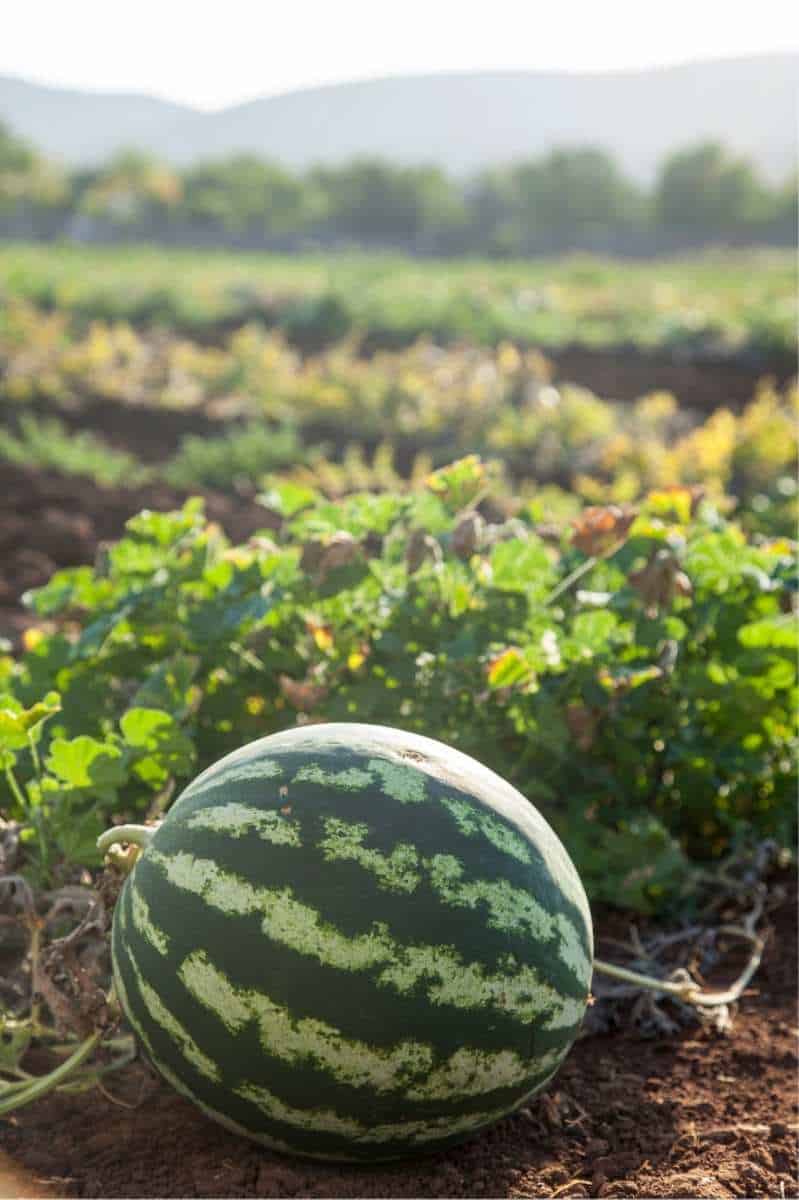
How to start watermelon seedlings indoors (only recommended for cooler climates or to ensure germination)
- Fill a large seedling pot or soil block with seed starting medium. We like to use coco coir (4 parts), vermiculite (2 parts), and perlite (1 part).
- Sow 2-3 seeds in each pot (this will ensure germination of at least one), about 1/2″ deep in the pot.
- Gently water the seeds (a mist or spray bottle is great for this!), and keep the soil evenly moist until germination.
- Keep the seeds somewhere warm, ideally where the soil can stay between 75-85°F. You’ll probably need a heat mat to achieve this temperature. You’ll see seedlings popping up within 7-10 days.
- Once you see the first set of true leaves (these are the leaves that look like melon leaves, not the initial leaves that came up when the seed first germinated), use small snips to clip off all but the strongest seedling in each pot.
- 7-14 days after your last frost date, plant the watermelon seedlings 36″ apart in the garden.
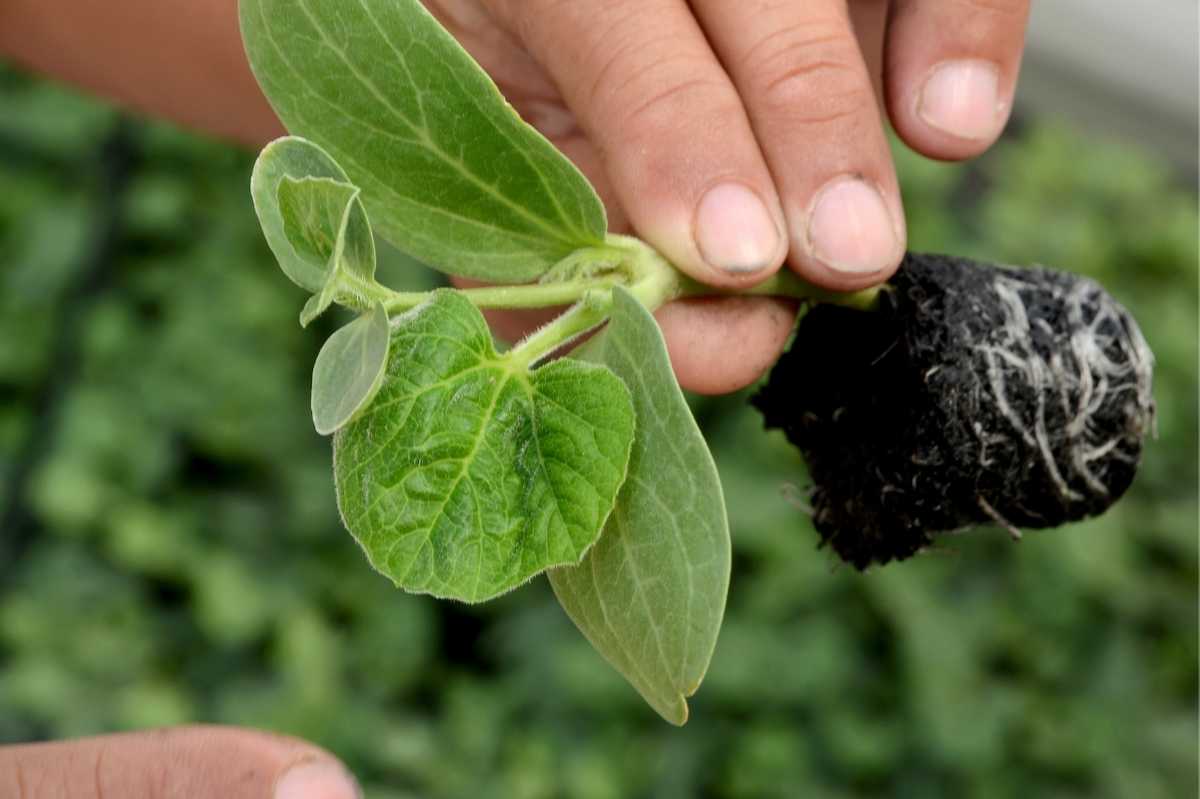
How do you prepare soil for watermelon?
The most important thing to remember when preparing your soil for watermelon plants is that they need the soil to be very warm to grow. Soil needs to warm to at least 70°F before watermelon plants can thrive.
Growfully Protip
Having a hard time getting your soil warm enough for watermelons? Row covers, cold frames, or even just a layer of thick black plastic can warm up soil quickly by trapping warm air near the soil surface.
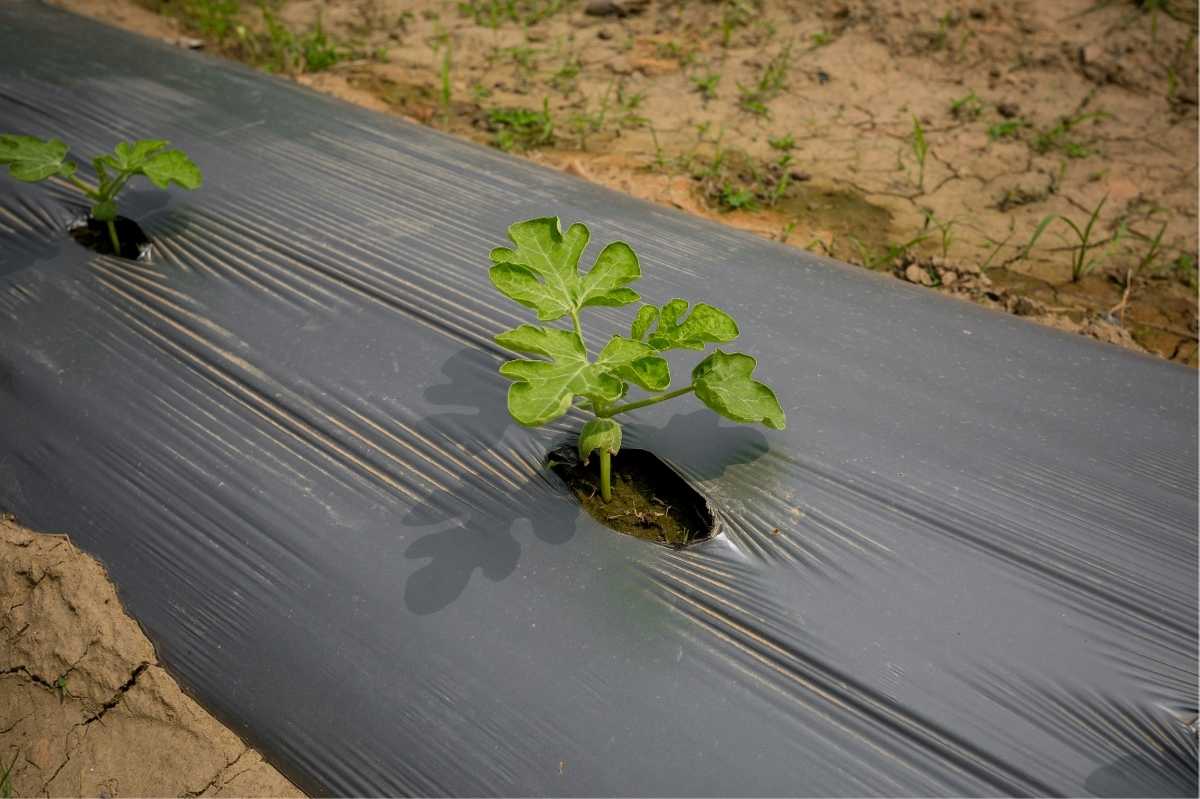
Watermelon plants prefer a soil pH of between 6.0-7.5—this range covers the vast majority of garden soils, but if you need to amend your soil to adjust pH, do so before planting.
Watermelons are heavy feeders, so you want to make sure you plant them in nutrient-rich soil to ensure they can produce lots of delicious melons. We recommend amending your bed with at least 1-2″ of well-rotted, rich compost or manure before planting. You can also amend your soil with a balanced, slow-release organic fertilizer.
Growfully Protip
Mulch is very important for watermelon plants to help retain moisture, reduce weed competition, and give cushion for the melons to grow on. We like a base of cardboard (to really stamp out weeds), topped with either weed-free straw or pine shavings.
Download Printable Watermelon Growing Guide »
How do I transplant watermelon seedlings?
Like we mentioned above, we don’t recommend doing watermelon transplants for most folks, but if you are transplanting watermelon seedlings, the key is to disturb the roots as little as possible.
- Make sure you have properly hardened off your seedlings to acclimate them to the weather. Ensure that your soil temperature is 70ºF or above.
- Transplant on a warm but not hot day that is preferably overcast with calm winds.
- Water your watermelon seedlings thoroughly about an hour before you plan on transplanting them.
- If using a plantable seed starting method (like newspaper pots, peat pots, or soil blocks), plant the seedling directly into the soil. You might want to (gently!) tear off the bottom of the newspaper pot or peat pot to encourage root growth.
- Water the plants in well.
- Don’t be surprised if your plants go through a bit of transplant shock—yellowing, drooping of leaves, or stunted growth. With a little TLC, they’ll bounce back and take off soon.

Do watermelon plants need a lot of sun?
Yes! Watermelon plants require full sun (8 to 10 hours daily) to produce melons.
What temperature do watermelons grow in?
Watermelons like it moderately hot, and they grow their best between 75°F and 95°F air temperature.
Do watermelons need lots of water?
Just like most other plants in your veggie garden, watermelons need 1 to 2 inches of water per week to grow adequately. This is particularly important when the watermelon plants are setting and growing fruit. A watermelon is made up of 92% water—if you want big, juicy watermelons, make sure your plants stay well watered!
Growfully Protip
The sprawling vines and large canopy of leaves of a watermelon vine can act like a mulch to help retain soil moisture and prevent weed competition around your watermelon plants.
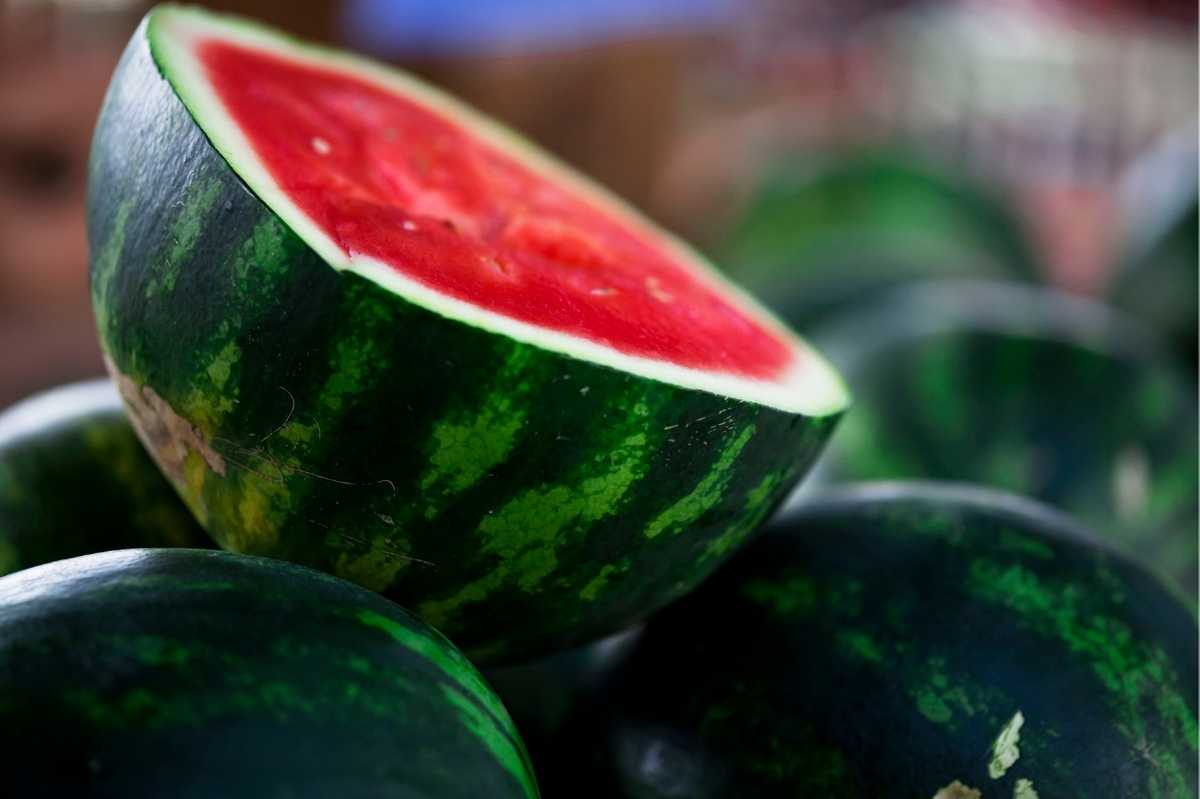
What can you plant next to watermelon?
The most important companion plant for watermelon are plants that can repel pests (like squash bugs or cucumber beetles) and can also attract beneficial pollinators that can help ensure your watermelon plant is pollinated and can set fruit.
In general, almost any flower (particularly a native flower) is a great option for intercropping with your watermelon to bring in pollinators. We also like using marigold, nasturtium, dill, and tansy to help attract pollinators and reduce pest pressure.
How do you grow a watermelon vertically?
We wouldn’t recommend you try to grow the Carolina Cross Watermelon (which can reach up to 200 pounds each!), but you can definitely grow some smaller baby and personal-sized watermelons vertically on a trellis. Look for melon varieties that have melons under 6-8 pounds, and then make sure you provide support for the growing melons on the trellis in the form of a melon hammock (you can make them or buy them).
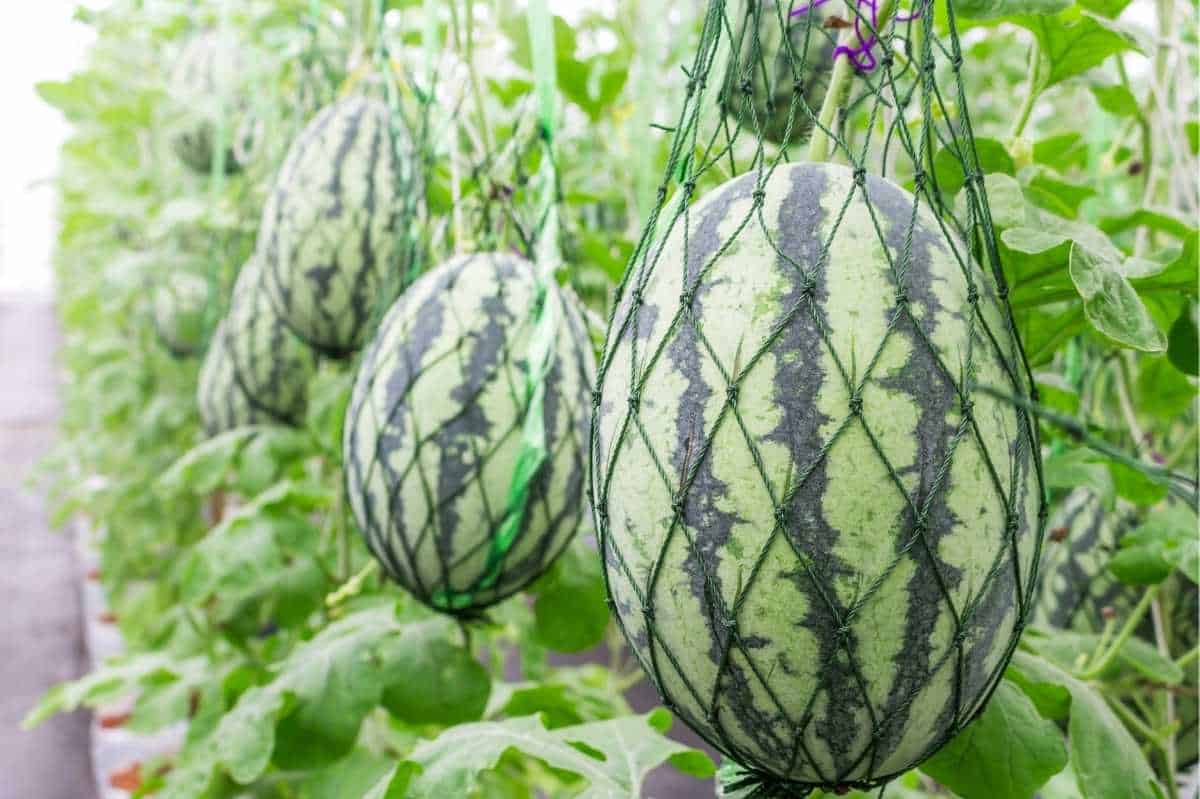
Growfully Protip
If you’re low on space, another option is to grow a bush variety of watermelon. Bush Sugar Baby watermelon plants only spread about 24-36″.
Do I need to fertilize my watermelon plants?
Watermelon plants are heavy feeders and can benefit from a regular fertilization schedule. We recommend using a nitrogen-heavy fertilizer while the plants are growing their stems, leaves, and canopy, like diluted fish emulsion. But then once the plants start to set fruits, you can switch to a fertilizer that has heavier phosphorus and potassium content to help encourage fruit set.
Should I cut back watermelon vines?
If you have a large enough garden space, we recommend allowing your watermelon vines to sprawl, instead of pruning them. This is mostly to ensure that there are enough female flowers and male flowers along the plant to ensure proper pollination.
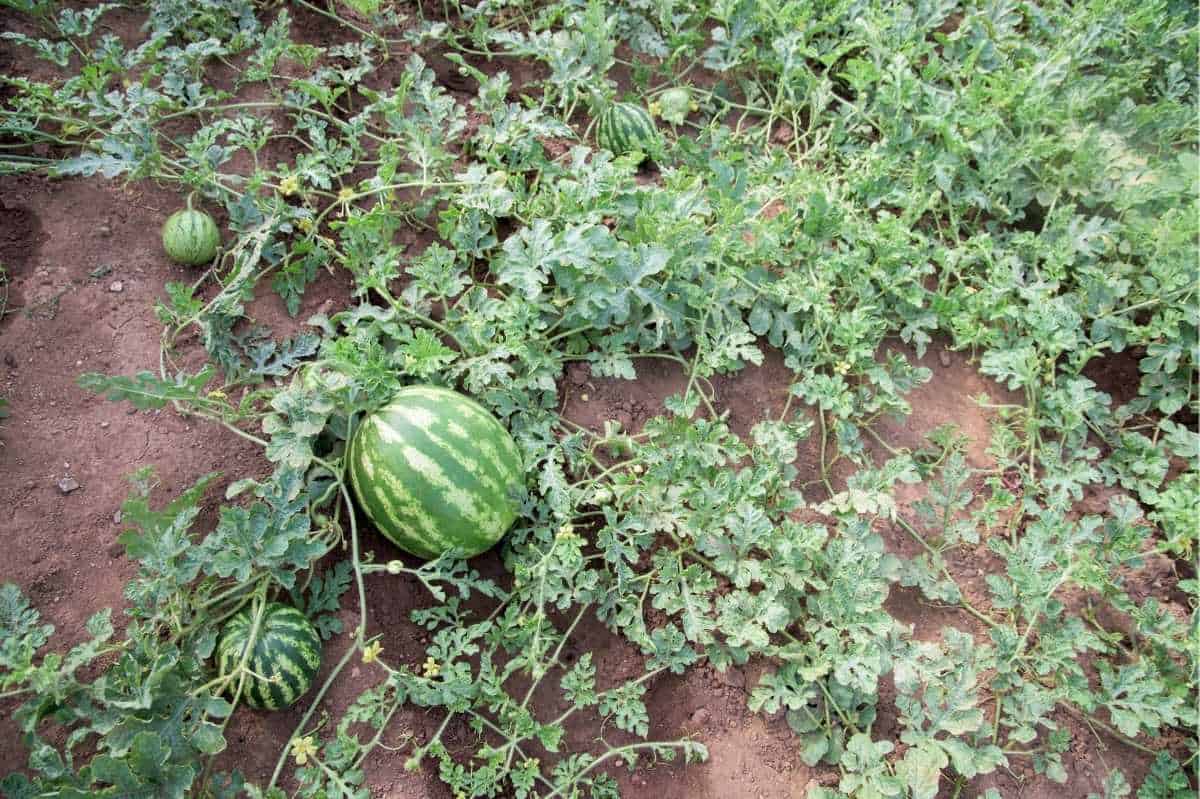
If you’re low on space, you can prune your watermelon vines to keep them in check—just make sure your plant has enough flowers for pollination. Cut back any weak or diseased vines, or vines that aren’t bearing, first.
Growfully Protip
Pruning watermelon vines too vigorously can cause the plant to put more energy into producing runners instead of setting fruit.
Do I need to rotate my crop?
Yes! We always recommend you rotate crops in your garden as much as possible to prevent diseases and pests. Watermelons should not come after or before any other melons, and if possible, any other members of the cucurbit family (winter squash, cucumbers, zucchini, summer squash, pumpkins).
How do you tell if a watermelon is sweet or ripe?
Ah, the age-old question—when do you pick a watermelon? Judging ripeness is one of the harder parts of growing watermelons, but luckily, there are a number of ways to tell when a watermelon is ripe. Here are the three methods we use:
- Field Spot: Flip the watermelon over and look at the spot where the watermelon has been on the ground (AKA: the field spot). If it is a golden, bright yellow—your watermelon is ready to harvest! If it’s a pale yellow, white, light green, or even just the color of the rind, it isn’t ready yet.
- Hollow Sound: Another good way to know when a watermelon is ripe is by sound. Knock on an UNRIPE watermelon with your knuckles (choose one you are sure isn’t ready yet). Then knock on the one you think might be ready. When the watermelon is ready, it’ll sound hollow compared to the unripe watermelon. This can be hard to hear the difference at first, but after a few rounds of watermelon thwacking, you’ll train your ears to know the difference.
- Browning Tendril: Another clue to look for is that the tendril and leaf closest to the stem of the watermelon should be starting to brown (or even look completely browned or yellowed).

How do you harvest watermelon?
Unlike cantaloupe, which just slip off the vine when ready, watermelon requires a little bit of work to harvest. You can take the melon, and then gently twist until it disconnects, or you can take some scissors or a garden knife and cut the melon at the stem.

How many watermelon will one plant produce?
The number of melons you’ll get out of your plants will largely depend on the cultivar you plant, the amount of bee and pollinator activity you have in your garden, and your growing conditions. But you can estimate that you’ll get at least 1-2 watermelons per vine.
Do watermelon plants come back every year?
Sorry, but no. Watermelon is an annual and will need to be replanted each summer.
What about growing seedless watermelons?
Seedless watermelons (AKA: triploid watermelons) are all the rage, but they do require a bit of special treatment to make sure they produce. Because seedless watermelons are, ahem, seedless, that means that you can’t just take a seed from a seedless watermelon and plop it in the ground to grow more.
Seedless watermelons seeds are made by crossing a normal diploid melon with a tetraploid parent. This produces a seed that will grow a sterile watermelon plant, but in order for that watermelon plant to produce seedless watermelons, the female flowers on the seedless plant must be pollinated by the male flowers from a fertile pollinator plant (a regular seeded variety).

In the home garden, this looks like growing at least one seeded watermelon per 2-3 seedless watermelon plants, and ensuring you have plenty of pollinator activity to encourage pollination. Most of the time, when you purchase a seedless watermelon seed packet, it will come with a pollinator cultivar to plant alongside.
Download Printable Watermelon Growing Guide »
Troubleshooting
Why are my watermelon plants not growing?
The two main causes of watermelon plants having slow growth are transplant shock and cooler temperatures. If you have recently planted your watermelon seedlings, give them some TLC and they should take off again within 1-2 weeks. If your weather has been cool, you can take solace in the fact that as soon as the temps creep up, your watermelon will take off!
I have beautiful plants, but no melons, or the melons that are on the vine shrivel up and die after a few days.
For many people, pollination is one of the trickiest parts of growing watermelon. Watermelon plants have both female flowers and male flowers, and pollen must make its way from the male flowers to the female flowers for pollination to occur and for a melon to begin growing.
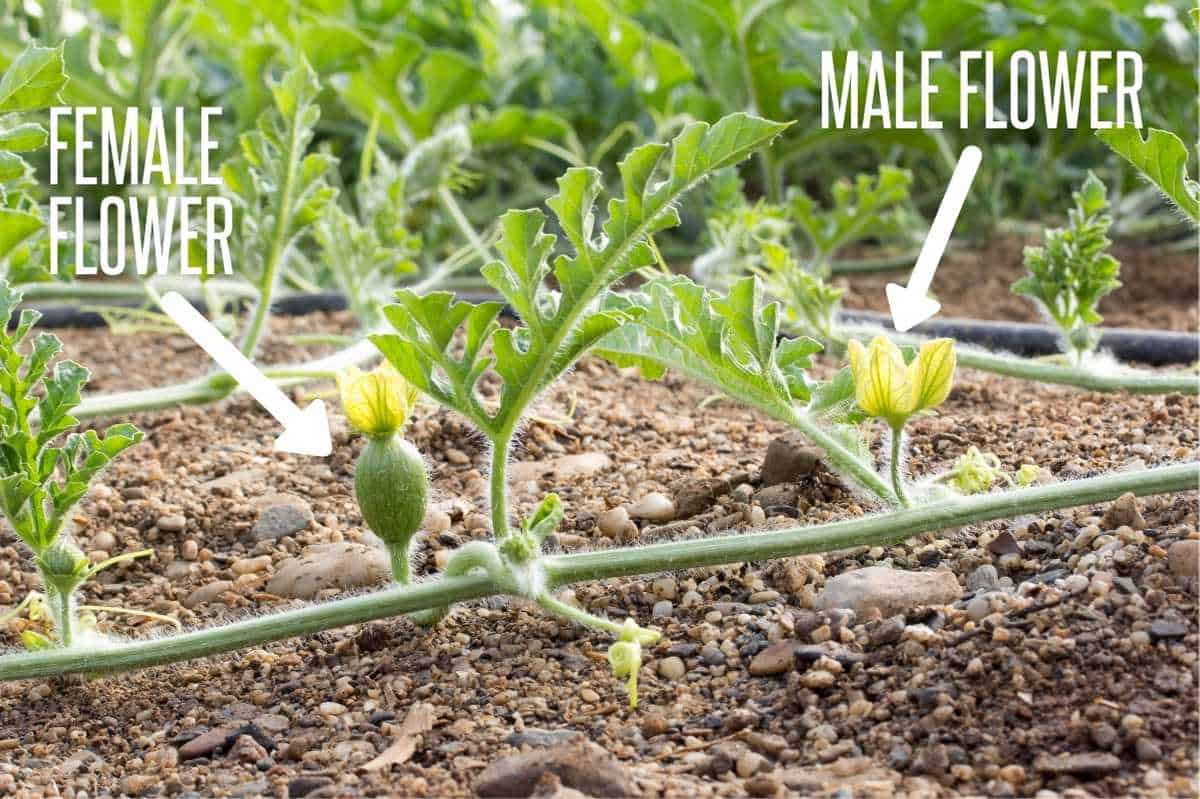
This means bees (and other pollinators) are your best friend for watermelon growing! If your watermelon vines aren’t setting any fruit, it could be that you have low pollinator activity in your area. You can plant companion flowers to attract pollinators, and you can also try hand pollination. To hand pollinate:
- Identify a male flower. These are the watermelon flowers that do not have a tiny watermelon on the stem.
- Take a soft paintbrush or cotton swab and run it along the middle of the flower. The brush or cotton swab should fill up with yellow pollen.
- Identify a female flower—these are the flowers that have a tiny melon growing on the stem.
- Brush the pollen-filled paintbrush or swab against the sticky inside of the female flower to spread the pollen.
- You’ll want to repeat this will multiple male flowers and female flowers. It requires multiple visits from bees to properly pollinate a female flower, so you’re trying to replicate as closely as possible.
How do I make my watermelon sweeter when growing?
If your watermelon isn’t very sweet, there is a good chance that it wasn’t completely ripe when you harvested it—even if it has deep red flesh and is juicy! Watermelons develop their sweetness towards the end of the ripening process, so even just a couple of days too early can mean all the difference when it comes to how sweet your melon is.

What about vine borers, cucumber beetles, and squash bugs?
Watermelon plants are not the favorite plant for most of the common cucurbit pests like squash vine borers, cucumber beetles, and squash bugs. However, they will enjoy feasting on a watermelon plant if that’s all that’s available. If you’re struggling with cucumber beetles or squash bugs, we recommend checking out our full troubleshooting articles on how to handle those.
I have tiny bugs on my watermelon plants!
Watermelon can be prone to both spider mites and aphids. If you notice either of these on your plants, you can remove them with a strong jet of water from your hose or by handpicking and smashing. If that doesn’t do the trick, diatomaceous earth, neem oil, or insecticidal soap should take care of the infestation, just make sure to read the label to ensure your application isn’t harming beneficial pollinator insects.

Alternaria leaf spot, anthracnose, gummy stem blight, fusarium wilt—oh my!
Because of the hot, humid weather they like to grow in, melons plans can be susceptible to a number of fungal diseases including alternaria leaf spot, anthracnose, gummy stem blight, and fusarium wilt.
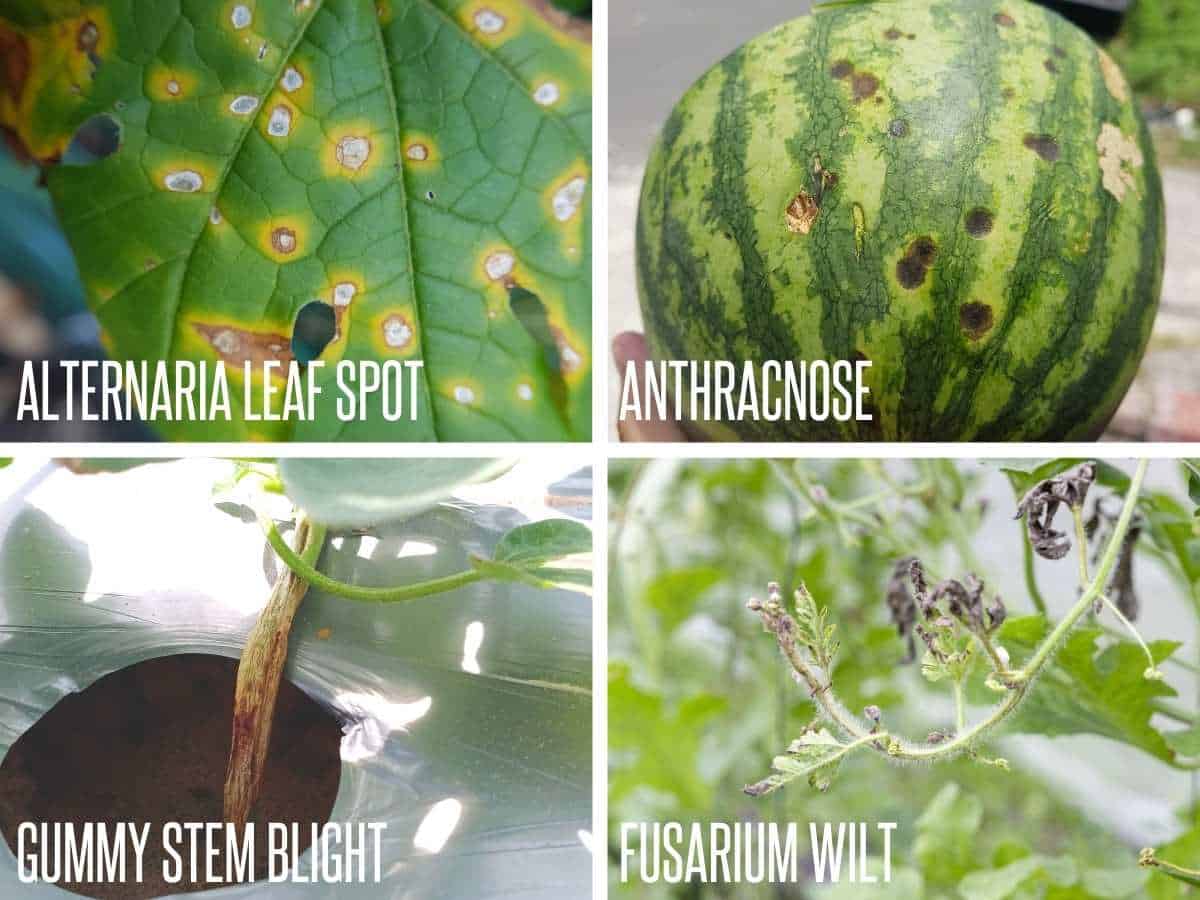
While these fungal diseases tend to present with different symptoms, the tips to preventing them all are about the same:
- Plant disease-resistant varieties (in particular, this will help prevent anthracnose and Fusarium wilt)
- Practice crop rotation. Don’t plant melons before or after other melons or cucurbits—especially if disease has been present.
- Destroy crop debris, especially from plants that are diseased.
- Use drip or other soil-based watering systems. Overhead watering—in particular frequent, short bursts of watering like from a sprinkler on a timer—can spread fungal pathogens.
- Make sure plants have wide enough spacing to improve air circulation.
Once you have a fungal disease on your watermelon plant, it can be hard to control. Some infections can be controlled by organic fungicide sprays. However, many fungal diseases are becoming resistant to commonly used fungicides, so it’s important to rotate your sprays if you choose to do this and only choose to use fungicide sprays as a last resort.
Download Printable Watermelon Growing Guide »

How To Grow Watermelon
Materials
- Watermelon seeds
Tools
- Nitrogen-heavy fertilizer
- Phosphorus and potassium-heavy fertilizer
- Rich, well draining soil
- Watermelon growing guide
Instructions

- Make sure the soil is warm. Wait until the soil is consistently 70°F or warmer before planting out your watermelon.
- Remember that watermelon are heavy feeders. Watermelon plants need lots of nutrients. While the plant is growing, use a nitrogen-rich fertilizer. Once the plant starts putting out fruits, switch to a fertilizer that has a heavier amount of phosphorus and potassium.
- Water thoroughly. Watermelons are made of 92% water, so make sure your plants stay well watered if you want juicy fruits!
- Water wisely. Water the soil, rather than the leaves and canopy, as much as possible, to help prevent fungal diseases.
- Give your plants space. Plant watermelon plants about 36" apart to allow for better air circulation. This will help prevent fungal diseases.
- Don't harvest too early. A watermelon harvested too early won't be nearly as sweet. Check for these signs of ripeness: a bright yellow field spot, a hollow sound when knocked, and a browning tendril close to the stem.
- Rotate your crops. To prevent diseases, do not plant watermelon in the same spot year after year, or immediately before or after other melon. If you can, avoid planting watermelon in the same spot before or after other members of the cucurbit family as well.

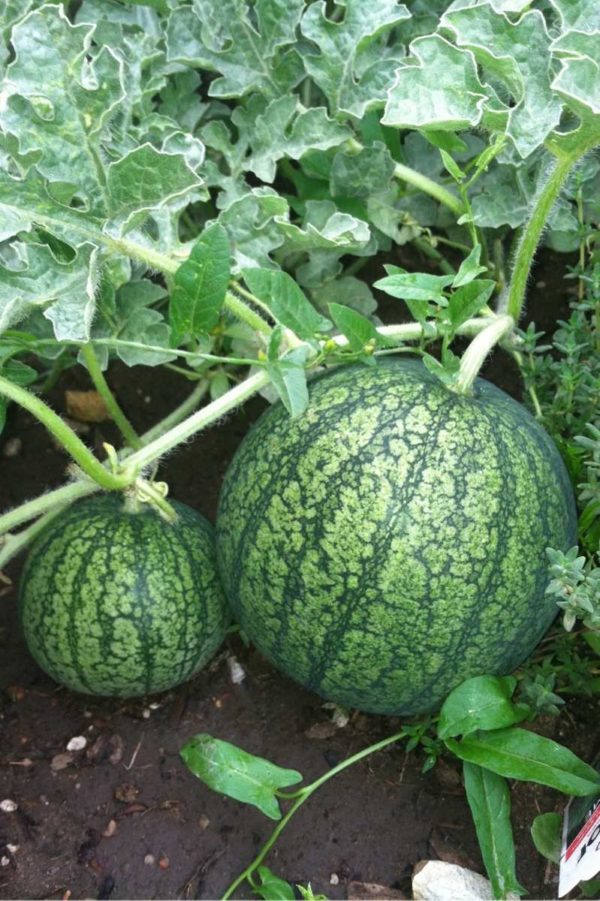






Hello, I have really enjoyed tips in this post. I.’m sure next year I’ll be a beginner in the watermelon project. Thanks alot for standing out to teach the young generation.
Thank You for Sharing this informative article! It is very useful to everyone Stay healthy and keep safe!
Watermelons are one of Texas’s top agricultural products, and if you live in the state, chances are you want to try your hand at growing them yourself. The best month for this is around April to July.
Comment*hello cathy,am from nothern uganda and am preparing a garden to grow watermelons. I will use your gardening tips to do this. Next november will be my planting month. The fruits will rippen in the dry season and in full sun. Am hopping to harvest sweet and tasty fruits. Thank you for the gardening tips you share on the web.
Thank you very informative a lot to absorb i learnd a lot from this and appreciate it very much thanks again ill be using these again in the future
Is it normal for young melons to have a yellow appearance? If not what should I do to fix them?
It could be blossom end rot, but it also could be the melon just didn’t get pollinated or some other plant stress going on (drought, disease, etc.).
If you suspect blossom end rot (if the end where the flower was is turning brown or squishy):
To prevent blossom end rot, you want to both make sure the calcium levels in your soil are adequate through regular soil testing and make sure you improve the methods through which plants uptake calcium. Namely: keep your cantaloupe plants evenly watered. Calcium is distributed through a plant through water, if there isn’t enough water, calcium has a hard time reaching the bottom of the melon—causing blossom end rot.
Good luck!
Hi wonderful information! I’ve never grown a vegetable/ fruit before so wanted to try growing a watermelon my favorite fruit! Anyway my question is this I have a metal round container that is circumference of 24ft/ 2ft. And about 11 inches deep. Can I grow a watermelon this way? Should I make a row and just place 3 seeds at one time in the same hole?
I was going to drill sever holes in the bottom of the container so that I had good water drainage. I live in Florida so it’s pretty hot all the time.
Thank you
Yes, that should work! And then thin the seedlings down to one plant per spot once they come up. For a raised bed that big, you will probably need lots of drainage holes so water doesn’t sit in the soil for too long.
Do you use raised beds for your melons? If so, what dimensions did you use?
We’ve done both in-ground and raised beds for our melon, and both have done well. We usually use the raised beds now for ease in the 4’x8′ beds, giving 36″ between melon plants.
Which pesticides should I use in the watermelon growth? I’m in Migori Kenya around the lake regions.
We try not to use pesticides if we can avoid it. Instead we plant other plants around our watermelon to deter pests and attract beneficial insects, as well as other organic methods of pest management.
Planning to plant some watermelon during summer here at our home garden but through all the information i do believe that i will success in my watermelon garden.thank you so much for the tips..
Very useful article for beginners and old farmers. The troubleshoot part provides solutions to most of problems encountered during the farming process.
Thank you for sharing.
Thank you for sharing this information, I live in the beautiful tropical Islands of Samoa and we have two seasons a dry and wet, in saying this wet season can have temperatures of 70-80°F our lowest recorded would be around 50°F would like to start growing after reading this it appears we can grow all year around. How do I measure the soil temperature or do I go by the weather thermometer pls
Hi Faitasi, There are soil temperature thermometers that you can use, or if you think it has been sufficiently warm recently, it might be fine to go ahead and plant.
I found the message significantly useful. Much as I have embarked on growing the plant this year, more of the data here will enhance endeavors in this undertaking.Thank you for the elaboration.
Extremely grateful for such wealth of information,. Unfortunately took seeds late to nursery and just when starting to flower, rains are setting in! All the same will make use of invaluable information second attempt. God bless you.
Hello,
When sowing seeds directly in the garden, is one seed enough to grow a seedling?
How far apart should seeds be from one another?
thank you!
Ana
One seed may be enough, but because seeds don’t have 100% germination rates, we recommend planting a few per hole to make sure one of them sprouts!
wonderful. Never come across a very well and detailed guidence like this one.